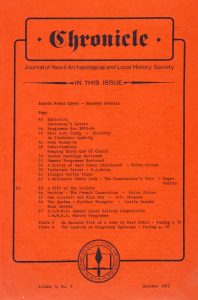1985-Oct-pg64_Herblay – The French Connection
This article came from the Chronicle published October 1985. Page 64
HERBLAY – THE FRENCH CONNECTION
Author: Moira Gittos
Members will remember that some time ago the Society sent a letter to Herblay with the Civic delegation, in the hope of making some contact with a like-minded group. Recently a reply has been received from Messieurs Jean-Paul and Gilbert Forget. They have generously sent a copy of a history of Herbleyo written by M. Gilbert Forget, with good wishes to our Society. M. Jean-Paul Forget has also contributed the following outline of the development of the name of Herblay:-
| Date | Name | Source |
|---|---|---|
| A.D. 754 | Arabrelidum | Appears in a latin document |
| 9th Century | Arablai | A Celtic version of the name |
| 1000 | ldrabletum | From a manuscript in latin |
| 1207 | Herbleyo | |
| 1210 | Erbledum | From a title (in latin) |
| 1226 | Herbledis | From a title |
| (Herbleio ) | ||
| End of 13th C. | (Erblay) | These are all from maps |
| (Herbleium) | ||
| 1365 | Erblay | From a Vente, in Paris |
| 1372 | Arblay | From an Arrêt, in Paris |
It appears that many of the early documents relating to Herblay were brought over to this country in about 1359, during the Hundred Years War.
The earliest remains discovered in the area were some animal bones dated between 8,000 and 4,000 B.C. and there is also evidence of human settlement in Neolithic times. The Romans began the exploitation of gypsum resources which continued until the 19th C. There was also a villa nearby. That during Merovingian times (roughly similar to our Saxon era) there must have been a reasonable settlement, is demonstrated by the existence of a cemetary. Situated close to the modern church, it was excavated between 1967 and 70. A contemporary structure of unknown use (perhaps either a monastery or castle) has also been found.
The reconstruction of the mediaeval history of the town has been complicated by the loss of many documents. In 1470 Herblay was a small village with ten fires, indicating a population of perhaps 30 – 50 people. The next 200 years saw an expansion of the village, until in 1695 there were 250 fires (750 – 1250 inhabitants). Presumably this rise was caused by the exploitation of the limestone quarries which in 1739 supplied stone for work at Versailles. In 1588 authorisation was given to build the town walls. From its 18th C, level, the population rose steadily until the turn of the century. Since 1900 the population has risen from 2,000 to its 1972 level of 17,000. Herblay also has a literary connection in that Charles le Prevost, a son of one of the lords of the manor in the 17th C. is believed to have provided the inspiration for the character of Aramis in Dumas’ “Three Musketeers”.
The source of this information is Gilbert Forget “Herblay”
